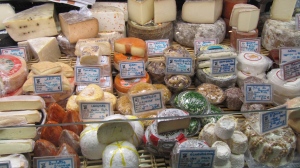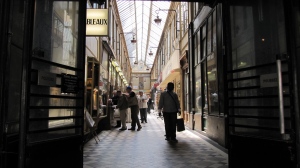quatre jours: four days
Journée 3 : Paris chic et gourmand (Chic and foodie Paris)
1. Rue Montorgueil (2e)
Start the day at the nothern end of Rue Montorgueil; this historic market street is home to the supposed best éclair in Paris, among a number of other famous and lauded fromageries, boulangeries, épiceries, et bistros. For breakfast, I’d suggest to poke your head into Eric Kayser for a morning pastry. The brioche au chocolat blanc is literally one of my favorite things to eat in Paris.
2. Saint Eustache
When you reach the southern end of Rue Montorgueil, pop into the church on your right – Saint Eustache. Don’t forget to check out the unique heart shaped windows, and when you leave out the front door, look for La Droguerie, a colorful tricotage shop.
3. Magasins de Cuisine (1e/2e)
As you leave Saint Eustache and pass by La Droguerie, continue to suivre Rue Coquillière to the point where it intersects with Rue du Louvre. On this corner stands E. Dehillerin, one of the oldest kitchen/restaurant supply stores in Paris, and a personal favorite shop of Julia Child. In fact, this whole neighborhood is filled with lovely cooking stores, appropriately surrounding the former site of Les Halles (the famed central Parisian market). Turn left out of E. Dehillerin, and follow Rue Jean-Jacques Rousseau to Rue Montmartre, where you will find several other worthwhile cooking stores, including Bovida and Mora.
4. Galeries et Passages Couverts (2e/8e)
After you’ve spent an hour or two playing le gourmand, follow Rue Montmartre north until it becomes Rue du Faubourg-Montmartre (this switch occurs when you traverse Boulevard Poissonière). On the left-hand side, at 31 bis, you will find the Passage Verdeau. This is one of a handful of gorgeous covered passages/galleries that remain from the mid-19th century, when the upper-crust of the rive droite found it safer and chicer to shop indoors. Only 20 or so of the original 150 passage remain, and they are truly some of the most spectacular, interesting, and overlooked attractions in Paris. (For a list of the most beautiful passages, click here or check out this website with a map of the passages (in French)). From Passage Verdeau, you can follow a series of passages until you find yourself near the Opéra.
5. Palais Garnier et Galleries Lafayette
When you’ve exhausted the succession of passages heading ouest from Rue du Faubourg-Montmartre, head towards the Galleries Lafayette on Boulevard Haussmann. This historic department store is one of the oldest in Paris, and the main building has a gorgeous stained glass ceiling (over the perfume section) that is not to be missed. Anyone craving a good peek at the Eiffel Tower – or who just wants to get their bearings – should head to the toit, where there is a lovely view of the Opéra de Paris(Palais
Garnier). The Palais Garnier is your next stop after Galleries Lafayette, a historic building known among tourists as the setting for the Phantom of the Opera (and a visit to the building will only reinforce your wildest theatrical fantasies). The place does feel downright haunted, and you cannot help but imagine the lavish soirées and opening nights of centuries passed. A self-guided tour is well-worth the 9€ entry fee, if you have the time.
6. Madeleine et macarons
From the Opéra, descend southwest along the Boulevard des Capucines, to Place Madeleine. Pop your head into the church, which has an impressive altarpiece (if you feel so inclined), or continue sans arrêt down Rue Royale to La Durée, the most famous macaron shop in Paris. Sweet tooths should definitely sample a smattering of mini-macarons; my favorite flavor is cassis–violet.
7. Saint Honoré et Palais Royal
While you nibble on macarons, quickly poke your head down to Place de la Concorde, renown as the spot where Louis XVI (and other important historic figures) lost their têtes to the guillotine. Head back north on Rue Royale, and swing right on Rue Saint Honoré, the most chic shopping street (no it’s not the Champs Elysées) in modern-day Paris. Home to stores such as the much-lauded concept store Colette, this street also runs adjacent to several historic squares, including the Place Vendôme and the must-see Palais Royal. Make sure to take a tour through the arcaded garden and courtyard of the latter monument, which houses such institutions as the most-prominent Parisian antiques dealer and the oldest (continually operating) restaurant in Paris.
8. Et après?
The nearby Louvre is actually lovely in the evening, whether for a jaunt through the courtyard or a proper visit to the musée. The Louvre des Antiquaires is also à côté – a veritable wonderland of antiques that could intrigue even the most bored of museum-goers. Or if you’re feeling outdoorsy, perhaps it’s time to vadrouiller through the Jardin de Tuileries. Those in the mood for a cocktail (or a nightcap) might enjoy a stop at le Fumoir, and the nearby Rue de l’Arbre Sec is a hot-bed of culinary hit-makers, housing some of the very best restaurants in Paris (if you haven’t made reservations, try for a spot at Le Garde Robe, a small bar à vins).
—vocabulaire—
fromageries, boulangeries, épiceries, et bistros > cheese shops, bakeries, grocery stores and bistros
brioche au chocolat blanc > white chocolate brioche
tricotage > knitting
suivre > follow
le gourmand > the foodie
traverse > cross
rive droite > right bank (of the Seine river)
toit > roof
soirées > parties
sans arrêt > without stopping
macaron > a typically Parisian dessert – meringue sandwich with jam or cream like filling
cassis-violet > blackcurrant-violet
têtes > heads
musée > museum
à côté > next door
vadrouiller > ramble
bar à vins > wine bar





